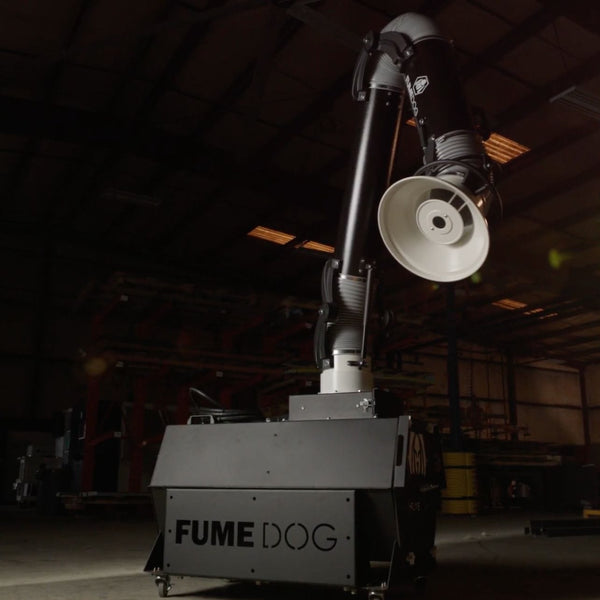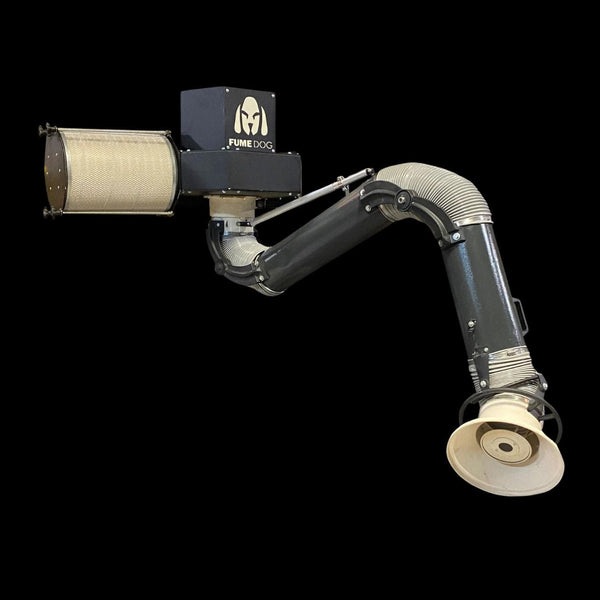
Many welders and industry workers are asking a critical health question: Can welding fumes cause cancer? The concern is valid, as recent evidence links these fumes to lung cancer and possibly other cancers such as kidney cancer. This article unpacks the connection between welding fumes and carcinogenicity, examining the substances involved and the measures you can take to minimize your risk.
Key Takeaways
- Mild steel welding fume has been reclassified as a human carcinogen, and welders face an increased risk of lung, kidney, bladder, and ocular melanoma due to exposure to carcinogenic substances like oxides of chromium, nickel, cadmium, and manganese.
- Various occupational risk factors including the type of welding, duration of exposure, and workplace environment impact the severity of health risks posed by inhaled welding fumes, which can lead to conditions such as COPD, neurological impairment, and occupational asthma.
- Effective protective measures mandated by health and safety organizations, such as local exhaust ventilation systems, personal protective equipment, and fume extraction solutions like those offered by Fume Boog, are essential for minimizing welders’ exposure to hazardous fumes and protecting them from related health risks.
The Carcinogenic Potential of Mild Steel Welding Fumes

Welders, the artisans who join the world’s metallic sinews, face a daunting adversary: the fumes emerging from their very craft. The Workplace Health Expert Committee’s recent reclassification of mild steel welding fume as a human carcinogen casts a new urgency on understanding the risks tied to these fumes, including the potential for metal fume fever.
No longer a mere nuisance, the welding fumes have been implicated by the World Health Organization International Agency for Research on Cancer as not just increasing the risk for lung cancer, but also hinting at a potential link to kidney cancer.
Stainless steel welding fume laden with an insidious mix of carcinogenic substances, including:
- oxides of chromium
- nickel
- cadmium
- manganese
These fumes are more than just byproducts – they are harbingers of health hazards that demand our attention due to excessive lung cancer risk.
Uncovering the Risks: Stainless Steel vs. Mild Steel
When we dissect the risks, the difference between stainless steel and mild steel becomes starkly apparent. Stainless steel welding activities unleash a cocktail of hazards, notably the toxic byproducts of hexavalent chromium, a villain in the realm of carcinogens linked to lung and nasal cancers.
The previous analyses have painted a grim picture, positioning stainless steel welding fumes as more hazardous than their mild steel counterparts, owing to a higher content of alloying elements and carbon. This dichotomy is a pivotal insight for welders and the industry, emphasizing the need for tailored protective measures against these toxic assaults.
Beyond Lung Cancer: Other Cancers Linked to Welding Fumes
However, the threat of lung cancer is merely the tip of the iceberg. Welders grapple with a spectrum of cancer risks, not just confined to the lungs but extending to organs such as the bladder, kidney, and even the eyes, where the shadow of ocular melanoma looms. Research underscores the grim reality that welders face increased risks of bladder and kidney cancers, painting a broader stroke of the carcinogenic risks to humans due to occupational exposure.
Moreover, the intense ultraviolet (UV) radiation from the welding process contributes to the risk of ocular melanoma, a rare but grave concern for those exposed. These findings cement the imperative for comprehensive preventive measures beyond the scope of respiratory protection alone.
The Mechanisms Behind Welding Fume Carcinogenicity

Peering into the molecular dance, the carcinogenicity of welding fumes reveals a complex choreography. These fumes, a fine mist of solid particulates, are born when metallic vapors cool and condense into tiny particles that range from the barely visible to the ultrafine. Laden with hexavalent chromium when welding stainless steel and high-alloy materials, as well as other notorious carcinogens like nickel and cadmium oxides, these particles are minuscule invaders capable of penetrating deep into the lungs and beyond. Among these, classified welding fumes pose a significant health risk due to their toxic composition.
The blanket statement of lung cancer risk from welding applies to all metal fumes, indiscriminate of the metal source, underscoring the pervasive nature of this occupational threat.
Inhalation and Accumulation: How Welding Fumes Enter the Body
The gateway for these microscopic adversaries is the very act of breathing. Welding fumes, when inhaled, embark on a perilous journey deep into the lungs, infiltrating the delicate alveolar sacs and even diffusing into the bloodstream. The routine inhalation of manganese fume particles, for instance, can wreak havoc systemically, culminating in neurological impairment that can shadow a welder’s life. Hexavalent chromium, nickel, and cobalt, found abundantly in welding fumes, are also known culprits of occupational asthma, manifesting as severe shortness of breath, wheezing, and chest tightness.
Even more concerning is the potential for these inhaled particles to contribute to the development of chronic obstructive pulmonary disease (COPD), a progressive lung condition that diminishes the quality of life over time.
A Closer Look at Occupational Risk Factors
Yet, not all welders share the same fate. A myriad of occupational risk factors influence the severity of health risks, sculpted by variables such as the type of welding, the duration of exposure, and the work environment. Cases like welder’s anthrax, a rare but severe pulmonary condition, emerge among those exposed to specific welding fumes, with symptoms that can escalate to fever and coughing up blood. These documented cases, predominantly affecting men in their prime, resonate with a geographical echo, appearing more frequently in regions like Texas and Louisiana.
The welders afflicted with this condition commonly worked with materials like A36 mil carbon steel, usually deploying welding processes such as electric arc welding, shielded metal arc welding, and Metal Inert Gas welding.
Protecting Welders from Harmful Exposure

Amid these risks, protection emerges as the beacon of hope. A hierarchy of controls, mandated by entities like the UK’s Health and Safety Executive, is essential to effectively reducing welding fume exposure. This layered approach to safety, which includes installing local exhaust ventilation for all indoor welding and mandating respiratory protective equipment for outdoor tasks, is no longer a recommendation but a necessity.
Fire-resistant fabrics, part of a welder’s protective arsenal, are also crucial in shielding the body from UV radiation, sparks, and flames. Fume Dog aligns with this protective mandate, offering portable fume extractors that actively capture fumes at their source, creating a safer welding environment.
Engineering Controls: Ventilation and Extraction Systems
The cornerstone of engineering controls lies in the local exhaust ventilation systems, designed to whisk away hazardous fumes from the welder’s breathing zone, thereby minimizing exposure. General area ventilation and enclosures are among the engineering efforts that should be integrated into the welding workspace to ensure clean air and safe lungs. At-source capture methods, such as those employed by Fume Dog fume extractors, stand out as effective countermeasures, removing contaminants before they can invade the welder’s breathing space.
In Australia, the legal obligations placed upon employers to minimize exposure to potentially harmful substances underscore the global importance of adequate ventilation and fume extraction in welding environments.
Personal Protective Equipment: A Critical Defense
While engineering controls form the first line of defense, personal protective equipment (PPE) serves as the critical second shield. The following PPE is essential for welding:
- Respiratory protection, such as disposable or reusable respirators and powered or supplied air respirators, must be tailored to the specific welding environment to ensure efficacy.
- Helmets with specially regulated filter lenses are indispensable in guarding against intense light and UV radiation, preventing ocular damage that can result from the welding process.
- Comprehensive eye protection is necessary due to the prevalence of eye symptoms among welders.
- Robust UV shielding is essential because UV radiation from welding is carcinogenic.
Moreover, the choice of protective clothing is crucial; heavyweight, tightly woven, and flame-resistant garments are essential to protect against the multiple hazards encountered during welding, including hot metal and UV radiation.
Fume Dog's Commitment to Welder Safety

Fume Dog stands at the forefront of the battle against welding fumes, offering a robust line of welding fume extraction systems designed to safeguard the health of welders. From portable systems that can be moved to the point of operation, to downdraft tables that capture fumes efficiently without the need for manual adjustments, Fume Dog’s solutions demonstrate a commitment to enhancing welder safety.
Nederman, within Fume Dog’s portfolio, carries the torch of innovation with solutions that are tailored for at-source fume capture, setting the industry standard for minimizing hazardous exposure.
Innovative Solutions for Welding Fume Extraction
Fume Dog’s arsenal against welding fumes is comprehensive, offering a range of products that cater to diverse welding environments. Portable extraction systems provide the flexibility to address fume extraction needs in a variety of settings, while downdraft tables offer a stationary solution for consistent performance.
The inclusion of wall-mounted extractors and welding booth extractors in Fume Dog’s product lineup further illustrates the breadth of options available to ensure a safe and healthy workplace. These innovative solutions champion the cause of welders’ health, ensuring that hazardous welding fumes are effectively removed from the breathing zone.
Why Choose Fume Dog?
But why should welders place their trust in Fume Dog? The answer lies in the meticulous engineering that goes into each extractor, ensuring optimal airflow that captures welding fumes effectively while preserving the integrity of the shielding gas – a crucial factor for welding quality. Flexibility is a hallmark of Fume Dog’s systems, allowing airflow adjustments at individual workstations to cater to different welding scenarios, offering tailor-made solutions for every welder.
Furthermore, the longevity of the filters, with an operational lifespan of approximately one year under specific conditions and regular maintenance, speaks volumes about the company’s dedication to providing long-term, reliable solutions.
Addressing Common Myths and Questions about Welding and Cancer

The welding industry is rife with myths and uncertainties, especially when it comes to the topic of cancer. It’s crucial to recognize that the International Agency for Research on Cancer has classified all types of welding fumes as Group 1 carcinogens, placing them in the same category as asbestos exposure and tobacco smoking.
While it’s true that welding, particularly due to ultraviolet radiation, can be associated with rare types of cancer like ocular melanoma, it’s the consistent, long-term exposure that poses the greatest threat. Individuals who have concerns about their health or potential exposure to cancer-causing agents due to welding should not hesitate to seek guidance from a medical professional.
Navigating International Guidelines and Standards
Understanding and adhering to international guidelines and standards is not just about compliance; it’s about protecting lives. The WHO/ILO Joint Estimates serve as a beacon in this endeavor, providing crucial figures that paint a picture of the disease burden caused by exposure to welding fumes. By employing a methodology that calculates population attributable fractions, these estimates offer a grounded perspective on the impact of welding fumes on lung cancer development.
The systematic review and meta-analysis conducted for these estimates consolidate a wealth of data, reinforcing the verifiable connection between welding fume exposure, deaths, and disability-adjusted life years (DALYs).
Real Stories: Welders and Their Battles with Occupational Hazards
Behind the veil of statistics and safety standards are the real faces of welders, each with a story that echoes the toll of occupational hazards. Here are just a few examples:
- The welder who, after years of inhaling welding fumes without proper respiratory protection, developed chronic bronchitis, a stark reminder of the consequences of inadequate safety practices.
- Another welder recounts the tale of severe respiratory issues from working in confined spaces with poor ventilation, a cautionary tale of the importance of workspace air quality.
- Then there’s the sobering narrative of a welder diagnosed with lung cancer, a life-altering condition attributed to prolonged exposure to toxic fumes.
These stories serve as a reminder of the importance of prioritizing safety in the welding profession.
These personal accounts, including a former welder’s struggle with debilitating neurological symptoms from inhaling manganese-containing fumes, underscore the urgent need for stringent safety measures and awareness of the risks associated with welding fume inhalation.
Summary
As we pull back the welding mask to reveal the broader vista, it becomes evident that the act of welding, though essential to our infrastructure, carries with it a silent burden – the risk of cancer from fume inhalation. The journey through the risks, mechanisms, and protective measures against welding fumes has been enlightening, underscoring the gravity of this occupational hazard. It is imperative that welders and employers alike heed the warnings and implement stringent safety protocols, from utilizing effective fume extraction systems like those from Fume Dog to donning the proper personal protective equipment. By embracing these defenses, the welding community can continue to forge ahead, building the world around us while ensuring their health remains safeguarded against the invisible threat of carcinogenic fumes.
Frequently Asked Questions
Are all welding fumes classified as carcinogenic, or only certain types?
All welding fumes have been classified as Group 1 carcinogens by the International Agency for Research on Cancer (IARC), indicating that they are carcinogenic to humans and can increase the risk of lung cancer and possibly kidney cancer.
How can welders protect themselves from the carcinogenic effects of welding fumes?
To protect themselves from the carcinogenic effects of welding fumes, welders should implement a hierarchy of controls, including using local exhaust ventilation systems for indoor welding and wearing respiratory protective equipment for outdoor welding. Regulatory filter lenses in helmets and fire-resistant clothing should also be used to further reduce the risk (2023).
What are some of the cancers linked to welding fume exposure, aside from lung cancer?
Aside from lung cancer, welding fume exposure has been linked to cancers such as bladder, kidney, and ocular melanoma due to the carcinogenic substances in the fumes and UV radiation from the welding process.
Can occasional exposure to welding fumes be harmful, or is it only a concern for professional welders?
Even occasional exposure to welding fumes can be harmful if safety measures are not followed, so it's crucial to always use appropriate protective equipment during welding activities.
What makes Fume Dog's fume extraction systems a reliable choice for welders?
Fume Dog's fume extraction systems are a reliable choice for welders due to their optimal airflow, capture efficiency, flexible design for different welding scenarios, and long operational lifespan of filters. These features ensure a clean welding environment and the preservation of shielding gas integrity





